
For many people, a power bank is now a permanent fixture for outdoor activities or a festival weekend, in addition to a tent and sleeping bag. It doesn’t always have to be a model from the well-known manufacturers Bluetti or EcoFlow. Even rather unknown brands are slowly but surely conquering the local market. Today we want to take a look at a medium-sized model. In the BougeRV Fort 1000 test, we check what the power station with LiFePO4 batteries has to offer at a fair price.
Specifications
| Battery capacity | 1,120 Wh |
| Dimensions | 32 x 22.9 x 29 cm |
| Weight | 13 kg |
| Constant maximum output power | 1,200 W |
| Temporary peak power | 2,400 W |
| Lifetime | 3,500 charging cycles |
| Charging options | Household outlet, solar, car port, combined charging (USB-C + outlet or solar) |
| Material | Aluminum and ABS plastic |
| Connectors | 2x AC ports, 2x USB-A, 1x USB-A QuickCharge 3.0 (18 W), 1x USB-C (60 W), 1x cigarette lighter (120 W), 2x DC ports (120 W) |
| Battery Technology | LiFePO4 |
| Price | € 999.99 * |
Scope of delivery
A look inside the packaging reveals the following contents:
- BougeRV Fort 1000 SyZ-G1000 Powerstation
- Power supply with charging cable
- Solar charging cable
- Car charging cable
- User manual
BougeRV Fort 1000 review: design and workmanship
- High build quality
- Material mix of aluminum and ABS plastic
- Transport handles for easy carrying
- 32 x 22.9 x 29 cm at 13 kg weight
First, let’s take a look at the appearance and build quality of the mobile energy storage device. The manufacturer BougeRV relies on high-quality coated aluminum for the casing. This is anything but typical. After all, many models from the competition rely on much cheaper plastic. In view of the quite low price, this is really remarkable. Not only the choice of materials, but also the build quality is pleasing. There is no creaking or cracking at any point.
In terms of color choices, black and aluminum looks are predominant. The manufacturer sets fine accents with the two carrying handles. These can hardly be overlooked thanks to eye-catching yellow. The compact dimensions of 32 x 22.9 x 29 cm allow the power station to fit comfortably in pretty much any trunk. The only annoying thing is that the handles clearly protrude. Thus, other things can only be stacked on it awkwardly. Carrying is also possible with a weight of 13 kg over a short distance without any problems, even without back pain.
However, competing models with a similar capacity show themselves to be significantly lighter in some cases. For example, the Jackery Explorer 1000 Pro (test). This one weighs almost two kg less. Both the inputs and outputs are located on the front of the mobile energy storage device. BougeRV has clearly arranged everything here. You will also find the display and the power switch here. All in all, the power station scores especially with a great workmanship.
BougeRV Fort 1000 Test: Outputs
- A total of 9 outputs
- Constant output power of up to 1,200 watts
- Temporary peak power of 2,400 watts
An important factor in the everyday suitability of any power station is, of course, the variety of connections. And here the Fort 1000 can score quite well. The manufacturer places a total of nine outputs on the front. Two Schuko sockets are available for camping utensils like hairdryers, toasters and lights. If you want to charge your smartphone or another small technical gadget, you will find a total of three USB-A ports. While two of the ports are in standard mode, a third one offers QuickCharge 3.0 with 18 watts of power. The manufacturer highlights the port with the popular fast-charging standard in the color orange. Besides USB-A, there is of course also USB-C. Unfortunately, we only find one port here. In view of the ever-growing importance of the port type, I would have been very happy about a second one.
One of the two standard USB-A ports could have given way for all I care. It is also a bit of a shame that the USB-C port only has a power of 60 watts. Many competitors like the UGREEN PowerRoam 1200 (test) have much more to offer with a USB-C power of 100 watts. In addition to the conventional ports, you will also find a 120-watt cigarette lighter (12 volts) as well as 2x DC ports. I find it a real shame that the Fort 1000 doesn’t have an inductive charging surface on the top. Meanwhile, even mini power stations like the Bluetti EB3A (test) have such a charging option. If you leave out the somewhat weakly equipped USB-C port and the missing inductive charging area, the ports are quite respectable. The vast majority of users will probably not miss anything in everyday camping and festivals.
BougeRV Fort 1000 test: Modern LiFePO4 batteries
- Lifetime: 3,500 charge cycles
- LiFePO4 battery technology
In terms of battery technology, the Bouge RV Fort relies on the latest standard that is currently prevailing in the field of power stations. More specifically, the manufacturer uses here modern LiFePO4 batteries. These score in terms of longevity and safety. On paper, the power station is supposed to last for 3,500 charging cycles until the maximum battery capacity shrinks to 80%. With a total capacity of a proud 1,120 Wh, it should probably take a few years to get through these cycles – especially as an average user. We find the decision for LiFePO4 very good. After all, it is not only the buyer who benefits from the longer active use of the power station. On top of that, a longer device life always means less waste, which in turn benefits the environment.
BougeRV Fort 1000 Test: Convincing Performance Data
In addition to battery capacity, it is of course the output power that is important in a power station. After all, it is not uncommon for users to want to operate several electrical devices at the same time on the mobile energy storage device. According to the manufacturer, the power supplier is capable of a continuous output of 1,200 watts. Our extensive test showed that the Fort 1000 even has a bit more power to offer. We tickled 1,289 watts out of the device via one of the Schuko sockets. A really good value! Should the energy supplier be asked for a bit more power, this is temporarily possible. Thus, it allows a peak load of 2,400 watts.
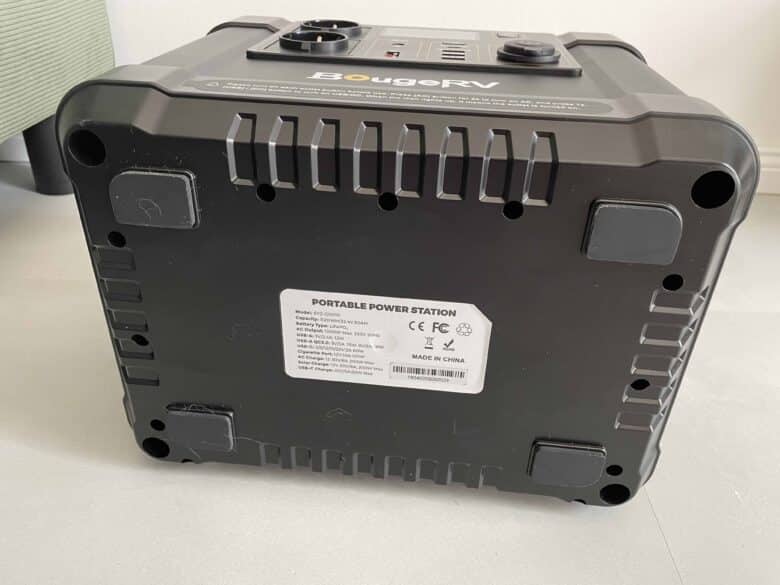
This is especially interesting for people who use their power station not only as an energy supplier for smartphone and notebook, but also primarily electronic devices. Campers can turn on their mini-fridge, coffee maker or even a microwave without hesitation. It is also conceivable to operate not too power-hungry little helpers in DIY mode. That’s how I was able to start up my angle grinder. However, everything has its limits – including the Fort 1000. Especially real power guzzlers like an electric grill come to an end here. Even the high temporary peak load didn’t help there. You should keep that in mind.
BougeRV Fort 1000 test: display difficult to see
- Display is prone to mirroring
- Power data is too small and hard to see
The pleasingly sharp display provides an overview of the powerstation’s current status. Not only can you see the current battery level of the mobile energy storage device. On top of that, you can see how high the current input or output power is. Unfortunately, the device doesn’t provide any data about the calculated remaining battery life or remaining charging time. While the battery status can be seen very well even at a certain distance, this is unfortunately not the case for the power data. Here you always have to approach the device to recognize the parameters.
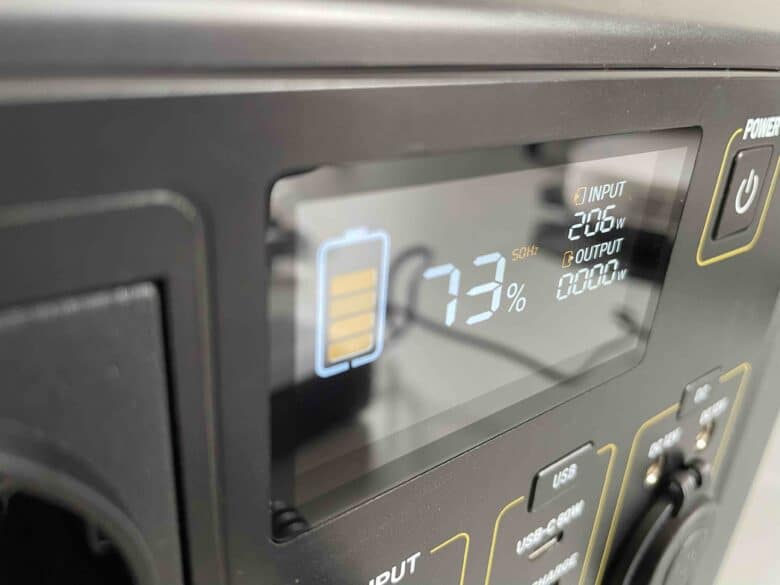
The poor visibility of the values would probably not be such a big deal if you could use a suitable app with the Fort 1000. Unfortunately, this is not the case with the Powerstation. Thus, you are forced to take a look at the device’s display. In view of this fact, it is a real shame that the manufacturer did not think along better here. Apart from this fact, I would have been very happy about a smartphone application. After all, such an application always provides more operating convenience. Just imagine that you are already lying in your sleeping bag and only want to briefly check once again whether the power station is actually switched off or is still outputting energy.
BougeRV Fort 1000 Test: Operation is foolproof
- Operation is straightforward
- Unfortunately, no app for remote control
- Loud fan noise
Even if an app would provide more ease of use, one still has to attest to the powerstation’s catchy and uncomplicated control. Anyone who has used a Powerstation before will immediately feel at home here. BougeRV provides the Fort 1000 with several buttons. Besides the hardly overlookable power button, you’ll find a suitable button for each output type. This way you can easily enable the outputs. The fans are another thing that affects the user’s comfort. This might not bother people who almost exclusively use their smartphone and other USB devices anyway. But as soon as the output power exceeds 500 watts, the cooling components are clearly noticeable. The whole thing is even more serious when charging.

Here, the fans are already rumbling from 200 watts input power. Since this power is reached by default when charging the batteries, you thus always have to live with the loud fan noise when charging. Detailed settings are missing here. That this is also possible without an app via a button on the device itself is proven, for example, by a FOSSiBOT F2400 (test) with its rotary control. Via this, you can determine the maximum input power. The loud fans are not really understandable from my point of view. After all, the Fort 1000 relies on an external power supply and does not install it in the power station itself. From experience, outsourcing the power supply always ensures that the fan noise turns out lower.
BougeRV Fort 1000 review: charging performance is outdated
- Charge time is at least 5 hours
I was actually disappointed by the charging performance. After all, the Fort 1000 with its 200 watts maximum input power is much weaker than competing models. A weak charging power may undoubtedly save the battery in the long run, making the device even more durable. Nevertheless, there are simply days when it has to go fast. In this case, very few people have time to charge their power station for just under 5.5 hours at the household socket. That’s how much time a complete charge takes. You will have to plan about the same amount of time if you charge the power station via a solar panel. A peak of 200 watts is also possible here. Charging with your own car is also possible. Here, the alternator of the vehicle is used.
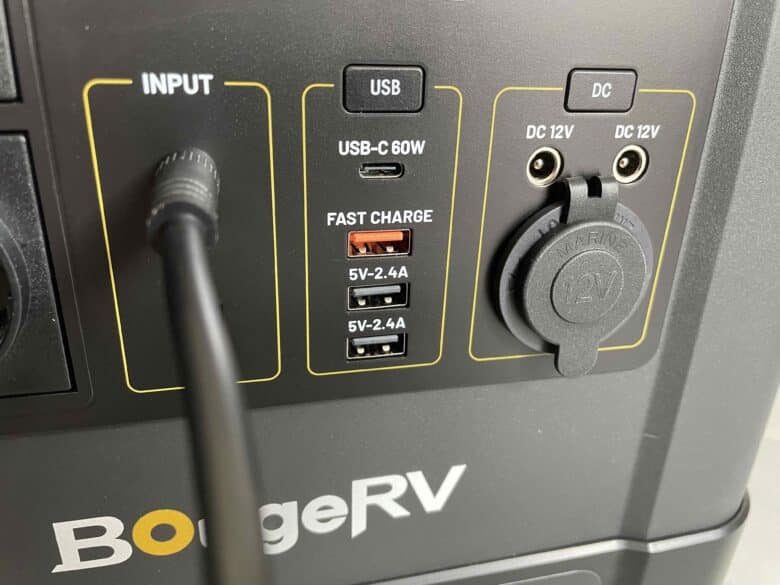
Those who choose this option will have to spend the most time. A charge namely takes about 9 hours. By the way, charging is fastest via combined charging via USB-C and socket or USB-C and solar. The Power Station probably needs less than 5 hours here. The feature that the energy storage can also be discharged during charging is cool. For example, you can immediately send the solar energy gained to your electrical devices at the campsite. In our opinion, more could have been done in terms of charging performance. This does not only apply to the charging speed and thus power. On top of that, it would be desirable if the Fort 1000 would allow combined charging via socket and solar.
Save 32% on the BougeRV Fort 1000 now!
Mit dem passenden Code kannst du die Powerstation derzeit auch außerhalb von Amazon zum Schnäppchenpreis bekommen. Im offiziellen Onlineshop von BougeRV kannst du mit dem Code tutorials25 ganz einfach 25% beim Kauf der Fort 1000 sparen.
With the right code, you can currently get the power station at a bargain price outside of Amazon. In the official online store of BougeRV you can easily save 25% with the code tutorials25 when buying the Fort 1000.
Conclusion
The BougeRV Fort 1000 scores with a great finish and high-quality materials. Thanks to the carrying handles, it can also be carried comfortably from A to B. The connectivity variety is solid. However, a second USB-C port and an inductive charging area would have been good for the power station. On the other hand, we were completely convinced by the great output power. However, you have to make sacrifices in terms of ease of use. The sometimes hard-to-see display, the missing app, a long charging time and the really loud fan limit the comfort quite a bit. If you don’t have any problems with that, you’ll get a real bargain in the power station sector, which is definitely worth a look.
BougeRV Fort 1000
Workmanship & design
Hardware
Usability
Value for money
83/100
The BougeRV Fort 1000 scores with a great price. Unfortunately, the power station also has many weaknesses.

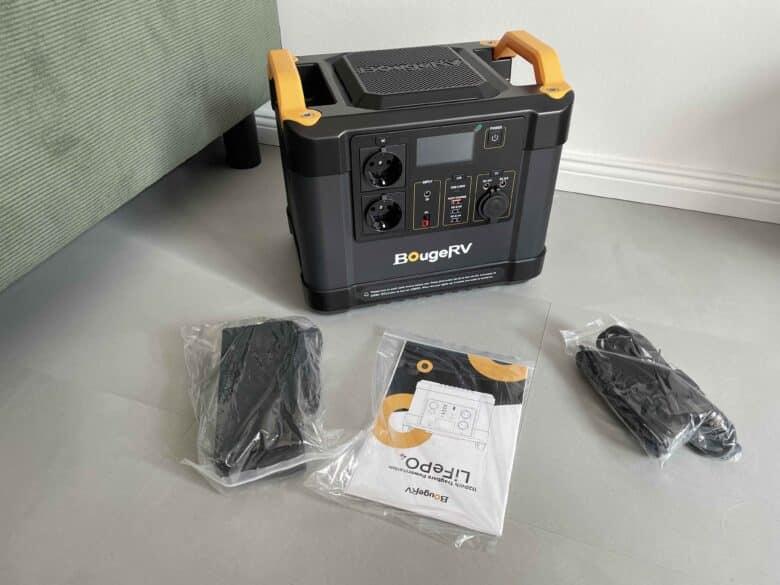

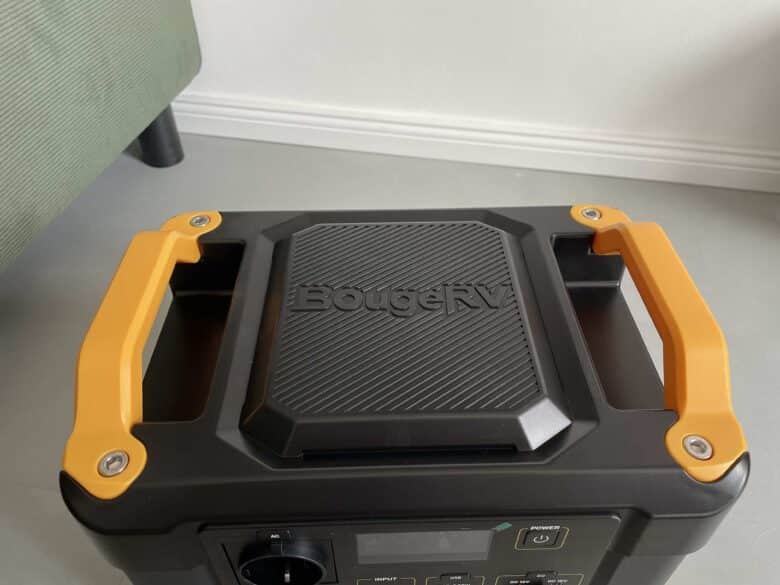
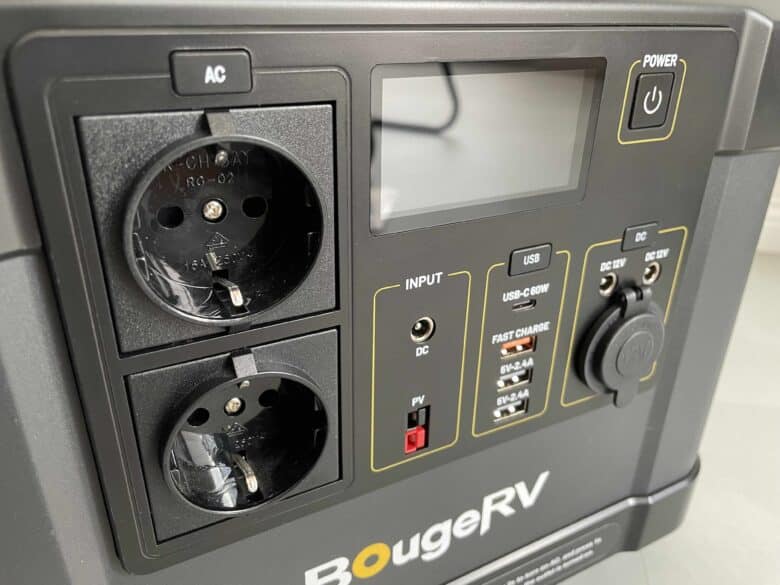


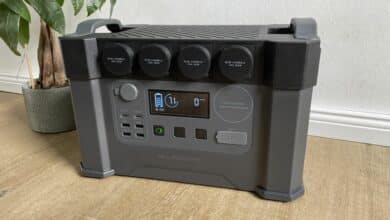
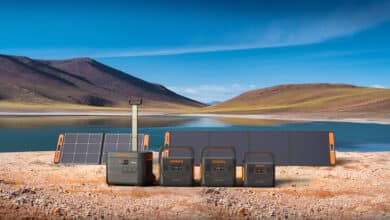

No replies yet
Neue Antworten laden...
Gehört zum Inventar
Beteilige dich an der Diskussion in der Basic Tutorials Community →